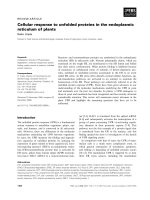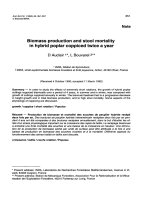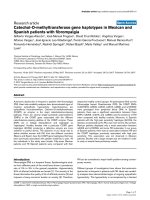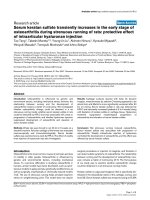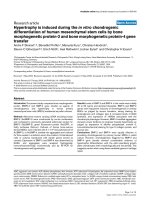Báo cáo y học: "Coming together to document mortality in conflict situations: proceedings of a symposium" docx
Bạn đang xem bản rút gọn của tài liệu. Xem và tải ngay bản đầy đủ của tài liệu tại đây (211.54 KB, 5 trang )
BioMed Central
Page 1 of 5
(page number not for citation purposes)
Conflict and Health
Open Access
Meeting report
Coming together to document mortality in conflict situations:
proceedings of a symposium
Ruwan Ratnayake*, Olivier Degomme and Debarati Guha-Sapir
Address: WHO Collaborating Centre for Research on the Epidemiology of Disasters, Université catholique de Louvain School of Public Health, 30
94 Clos Chapelle aux Champs, 1200 Brussels, Belgium
Email: Ruwan Ratnayake* - ; Olivier Degomme - ; Debarati Guha-
Sapir -
* Corresponding author
Abstract
The use of epidemiology in documenting the mortality experience in complex emergencies has
become pervasive in humanitarian practice. Recent assessments in Iraq and Darfur have provoked
much discussion on the assessment of mortality in scientific and policy spheres. In this context, the
Centre for Research on the Epidemiology of Disasters and the Harvard Humanitarian Initiative held
an inter-disciplinary symposium to examine the topic among epidemiologists, demographers,
forensic scientists and legal and human rights investigators.
We aimed to strengthen the scientific understanding of mortality estimation by reviewing progress
across fields and building inter-disciplinary bridges. We report on the presentations and discussions
here.
Introduction
The use of epidemiology in documenting the mortality
experience of complex emergencies has become pervasive
across humanitarian practice. Although used primarily as
an operational tool, in recent years epidemiological prac-
tice has been placed front and centre in the larger debates
over the deaths of civilians in Darfur and Iraq. Several
other approaches have long been used to assess mortality
in conflict settings, including forensic analyses of causes
of death and investigations into the abuses of those who
have perished.
This overlap is not exactly a coincidence. Mortality is the
ultimate indicator of human health and has wide-ranging
implications on the understanding of the scale of a crisis
on a population, the use of violence against civilians and
culpability. But how can disciplines such as epidemiol-
ogy, demography, statistics, law, human rights documen-
tation and forensic science best coordinate with each
other to describe the mortality experience of civilian pop-
ulations? Each field has distinct objectives. There is a need
to develop an understanding of these objectives to ulti-
mately provide a coherent understanding of various
numerical estimates and accounts. This will improve sci-
entific communication and prevent confusion among the
end users of these estimates.
On November 6
th
and 7
th
, 2008, the Centre for Research
on the Epidemiology of Disasters (CRED) together with
the Harvard Humanitarian Initiative (HHI) held a break-
through symposium in Brussels, Belgium to open the dia-
logue between disciplines [1]. The main objectives were to
strengthen the scientific basis of mortality documentation
by drawing on recent progress in the disciplines of field
Published: 25 February 2009
Conflict and Health 2009, 3:2 doi:10.1186/1752-1505-3-2
Received: 8 January 2009
Accepted: 25 February 2009
This article is available from: />© 2009 Ratnayake et al; licensee BioMed Central Ltd.
This is an Open Access article distributed under the terms of the Creative Commons Attribution License ( />),
which permits unrestricted use, distribution, and reproduction in any medium, provided the original work is properly cited.
Conflict and Health 2009, 3:2 />Page 2 of 5
(page number not for citation purposes)
epidemiology, demography, forensic science, statistical
analysis and human rights investigation and to build
bridges between disciplines for improved and reliable
estimation.
Although meetings within each discipline have been held
previously, we believe that this is the first to bring such a
diverse array of actors together. An important precursor to
this meeting was held in 1998 by the U.S. National Acad-
emy of Sciences to review the then nascent field of mortal-
ity estimation among displaced populations [2]. For the
current meeting, CRED and HHI brought together forty
discussants from thirty organizations representing
academia, non-governmental organizations, interna-
tional organizations, governments and United Nations
agencies (see Appendix 1 for full list).
Which methods are used?
The sessions explored various topics concerning methods
and applications. The broad objectives of estimation and
documentation were first laid out. Pierre Salignon from
the Health and Nutrition Tracking Service, an inter-agency
initiative for the generation of coherent data across
humanitarian emergencies, discussed the role of mortality
data in advocating for populations in crisis [3]. He
described Médecins Sans Frontières' efforts to systemati-
cally document violence against civilian populations in
Congo-Brazzaville in 2000. Helge Brunborg from Statis-
tics Norway then explained the role of the demographic
estimation of mortality for judicial purposes with refer-
ence to his work with the International Criminal Tribunal
for the Former Yugoslavia (ICTY) [4]. Through an opera-
tional perspective gained from missions with the World
Health Organization and the International Rescue Com-
mittee, Les Roberts emphasized the use of mortality data
for the direction of humanitarian health programs in the
Democratic Republic of Congo and other key crises [5].
This session provided a framework for a cross-disciplinary
discussion of methods and challenges to investigations.
The methods used to collect primary data vary by the
point in time during which they are applied. Overviews of
'in situ' methods conducted during a conflict and chal-
lenges posed by these methods were given. Presenters
described retrospective sample surveys conducted prima-
rily by nongovernmental organizations for operational
purposes (Olivier Degomme, CRED), prospective surveil-
lance systems maintained during a war in Guinea-Bissau
(Jens Nielsen, Bandim Health Project) and the use of wit-
ness accounts to highlight human rights violations among
Darfurian refugees in Chad (Jan Pfundheller, Atrocities
Documentation Team) [6-8].
Forensic investigation, which can elucidate violent causes
of death and age and sex characteristics of victims, can be
applied at the point where human remains can be care-
fully recovered. The application of forensic approaches
was described using the cases of mass gravesites in Bosnia
and Herzegovina (in Praća and Rahunići), Sri Lanka and
across Guatemala (Tal Simmons, University of Central
Lancashire and Fredy Peccerelli, Guatemalan Forensic
Anthropology Foundation) [9,10].
Researchers may take a more thorough look at the larger
mortality experience using secondary data collected at an
earlier point in time. Aggregation and tallying methods
can be used to draw a cohesive picture of mortality estima-
tions across a particular crisis. The amassed results of field
surveys conducted at sub-national geographical areas
(Olivier Degomme, CRED) and at the global level
through the multi-country, retrospective Demographic
and Health Surveys and World Health Surveys conducted
by UN agencies (Ziad Obermeyer, Institute for Health
Metrics and Evaluation) can be used to explore trends at a
national level [11,12]. Challenges to the use of secondary
data, precision and biases inherent to surveys in conflict
areas were outlined. Another approach, multiple systems
estimation, also uses multiple though disparate data
sources (including surveys, qualitative testimonies and
graveyard censes) to compare single-source mortality esti-
mations. Its use to estimate deaths in Timor-Leste between
1975 and 1999 was described (Romesh Silva, Benetech)
[13].
Investigators have been innovative in their use of both
conventional and new technologies to make estimations
in specific crises. The use of databases of validated media
reports in the current Iraq conflict (Hamit Dardagan, Iraq
Body Count), extensive reviews of state of the art mortality
data sources for prosecution purposes at the International
Criminal Court (ICC) (Guillermo Bedoya Jimenez, ICC)
and satellite imagery to assess the extent of the burning of
villages in Darfur (Phil Clarke, Bloodhound) were dis-
cussed [14-16]. These approaches represent important
developments in addressing mortality estimation in areas
where humanitarian access is poor, rigorous data collec-
tion is problematic and questions of the geographical dis-
tribution of mortality persist.
What are the pitfalls and limitations of mortality
documentation?
Whether using primary or secondary data, methodologi-
cal issues in the collection and analysis of data collected
during active conflict are inherent to the exercise. With ref-
erence to the demographic analysis of mortality in Iraq,
the duration of the war is difficult to pinpoint, credible
baseline mortality rates may be unavailable and estima-
tions of the base population are greatly affected by the
available data on demographic changes (Beth Osborne
Daponte, Yale University) [17]. Similarly, questions
Conflict and Health 2009, 3:2 />Page 3 of 5
(page number not for citation purposes)
remain as to the acceptable precision of well-used sam-
pling designs in the estimation of violent deaths, as dem-
onstrated by an analysis of the results of the 2004 Iraq
Living Conditions Survey (Michael Spagat, University of
London) [18].
The collection of data in the field can be an extremely dif-
ficult logistical challenge. Surveys of the affected crisis
regions of Darfur, Sudan by the World Health Organiza-
tion and the Democratic Republic of Congo by the Inter-
national Rescue Committee (IRC) have faced security and
logistical obstacles that intensify the methodological lim-
itations and risk to personnel, hinder the implementation
of best practices and ensure that difficult choices must be
made throughout the data collection period (Alessandro
Colombo, IRC) [19]. Similarly, personal risk may be
extended outside of the field situation due to the nature of
the inquiry. Threats to the lives of investigators have per-
sisted during forensic investigations in Guatemala (Fredy
Peccerelli, Guatemalan Forensic Anthropology Founda-
tion) [20]. In both cases, investigators and field personnel
require skills in negotiation and an acute sensitivity to the
political environment.
The application of data to humanitarian interventions
also faces obstacles. Statistical issues in the evaluation of
interventions to reduce mortality are rendered difficult in
the absence of a control group that is unaffected by con-
flict (Jens Nielsen, Bandim Health Project) [21]. Data col-
lected in order to understand the political trajectory of
violence, such as in the widely-used Centre for Civil War/
PRIO battle deaths dataset, has less immediate use for
humanitarian programming (Bethany Lacina, Stanford/
PRIO) [22]. Though it may serve as a valuable evidence for
humanitarian intervention, the utilization of mortality
data to make timely policy decisions is dependent on the
available data which may be anecdotal, unsound or
unrepresentative (Mark Phelan, U.S. Department of State)
[23].
How can we move forward?
The symposium clearly opened more doors and derived
more questions than could be adequately explored over
two days. Participants carefully reflected on avenues for
collaboration among disciplines, to move past speculative
discussions and attempt to put new thoughts to practice.
Collaboration in this case can be a difficult proposition.
Debarati Guha-Sapir, of CRED, stated that it is relatively
easy and scientifically safe to stay within one's bounds by
avoiding inter-disciplinary collaboration. Les Roberts
remarked that collaboration may face significant impedi-
ments due to the core objectives of different fields. For
instance, the public health approach utilizes epidemio-
logical tools to derive aggregated, confidential mortality
data at the population level for the objective of directing
humanitarian programmes. The judicial needs however,
may require that mortality data is substantiated by the
identification of victims. There also exist tradeoffs in com-
mitting resources for the extensive documentation of
mortality for legal purposes as done for the ICTY versus
obtaining a range of precision for the purpose of human-
itarian practice.
'Serendipity', or the act of accidentally discovering some-
thing fortunate, is the other side to the coin. Catrien
Bijleveld, a criminologist with VU University Amsterdam,
used this word to describe discussions throughout the two
days [24]. Participants remarked that the level of detail in
the cost-effective satellite imagery presented by Blood-
hound could greatly inform the interpretation of their
own epidemiological findings. Most discussants did not
have significant experience with forensic investigation.
The application of this science to adequately determine
the age, sex and cause-of-death among samples of victims
can fill important voids in the interpretation of data for
other disciplines where this information is difficult to
obtain. Several other examples, relating to methodologi-
cal issues between epidemiology and statistics were recog-
nized as representative of larger issues within the core
disciplines.
War itself will always be a divisive and value-laden issue.
The field of public health has been reticent to acknowl-
edge its specific ability to address conflict [25]. More
recently, conflict epidemiology has emerged as its own
discipline, and it follows that the debates of civilian
deaths in Darfur and Iraq have truly reached the broadest
levels of political, scientific and media discourse. Given
this intense environment for scientific progress, responsi-
bility for good quality data and the potential impact on
human well-being, it is unsurprising that the symposium
fostered healthy debate and genuine tensions over the
core scientific approaches for mortality estimation.
Mutual respect for scientific disciplines is imperative
though respectful debates are valuable. Upon reflection,
one participant summarized the reality which underlies
this tension and hence the basis for such a symposium:
'there is no incompatibility here; [debate] is the nature of
science'.
Competing interests
The authors declare that they have no competing interests.
Authors' contributions
RR drafted the report. All of the authors organized the
symposium, contributed to revising the manuscript and
gave final approval of the manuscript.
Conflict and Health 2009, 3:2 />Page 4 of 5
(page number not for citation purposes)
Appendix
Appendix 1: organizations represented
Amnesty International
Atrocities Documentation Team for Darfur
Bandim Health Project, Statens Serum Institut
Benetech Human Rights Data Analysis Group
Bloodhound
Brigham and Women's Hospital, Harvard University
Bureau of Population, Refugees, and Migration, U.S.
Department of State
Centre for Research on the Epidemiology of Disasters
Deutsches Institut für Wirtschaftsforschung (DIW Berlin)
Epicentre
Guatemalan Forensic Anthropology Foundation
Harvard Humanitarian Initiative
Health and Nutrition Tracking Service
Households in Conflict Network
Independent science writer
Institute for Health Metrics and Evaluation, University of
Washington
Institute for Social and Policy Studies, Yale University
International Criminal Court
International Peace Research Institute Oslo (PRIO)
International Rescue Committee
Iraq Body Count
Médecins Sans Frontières Belgium, France and UK
Netherlands Interdisciplinary Demographic Institute
Program on Forced Migration and Health, Columbia Uni-
versity
Royal Holloway College, University of London
School of Forensic and Investigative Sciences, University
of Central Lancashire
Small Arms Survey
Special Court for Sierra Leone
Stanford University
Statistics Norway
Trinity College Dublin
Université catholique de Louvain
University of Antwerp
VU University Amsterdam
World Health Organization
References
1. Centre for Research on the Epidemiology of Disasters: Doc-
umenting Mortality in Conflicts [ />]
2. Keely CB, Reed H, (Eds): Forced Migration and Mortality: Roundtable on
the Demography of Forced Migration. Committee on Population National
Academy Press: Washington, D.C; 1999.
3. Salignon P: Advocacy perspectives on the use of mortality
data. [ />].
4. Brunborg H: Use of mortality data at an international criminal
court. [ />].
5. Roberts L: Program uses of mortality data in emergencies.
[ />].
6. Degomme O: Retrospective mortality surveys. [http://confer
ence.cedat.be/abstracts#degomme1].
7. Nielsen J: Working with communities: approaches to collect-
ing data in the field: continued surveillance during the war in
Guinea-Bissau 1998–99. [ />abstracts#nielsen1].
8. Pfundheller J: Documenting atrocities in Darfur. [http://confer
ence.cedat.be/abstracts#pfundheller].
9. Simmons T: Forensic anthropology. [ />abstracts#simmons].
10. Peccerelli F: Fundacion de Antropologia Forense de Guate-
mala. [ />].
11. Degomme O: Identifying trends using small-scale mortality
surveys. [ />].
12. Obermeyer Z: Estimating conflict mortality from population-
based surveys. [ />].
13. Silva R: The Demography of conflict-related mortality in
Timor-Leste (1974–1999): empirical quantitative measure-
ment of civilian killings, disappearances & famine-related
deaths. [ />].
14. Dardagan H: Iraq Body Count: putting the data to work.
[ />].
15. Bedoya Jimenez G: The Use of mortality data by the office of
the prosecutor. [ />].
16. Clarke P, Höfer Petersen A, Tullin LL: Estimating violent mortal-
ity in Darfur at the village level. [ />abstracts#clarke].
17. Osborne Daponte B: Challenges in making wartime estimates
of Iraqi civilian casualties. [ />abstracts#osborne].
18. Spagat M: The Reliability of cluster surveys of conflict mortal-
ity: violent deaths and non-violent deaths. [http://confer
ence.cedat.be/abstracts#spagat].
Publish with Bio Med Central and every
scientist can read your work free of charge
"BioMed Central will be the most significant development for
disseminating the results of biomedical research in our lifetime."
Sir Paul Nurse, Cancer Research UK
Your research papers will be:
available free of charge to the entire biomedical community
peer reviewed and published immediately upon acceptance
cited in PubMed and archived on PubMed Central
yours — you keep the copyright
Submit your manuscript here:
/>BioMedcentral
Conflict and Health 2009, 3:2 />Page 5 of 5
(page number not for citation purposes)
19. Colombo A, Brennan R: Mortality surveys in countries in crisis:
political and security constraints. [ />abstracts#colombo].
20. Peccerelli F: Security issues for field investigations. [http://con
ference.cedat.be/abstracts#peccerelli2].
21. Nielsen J: Pitfalls, challenges and limitations to documenting
conflict mortality: statistical challenges and methodical
issues. [ />].
22. Lacina B: War mortality statistics in conflict research: CSCW,
PRIO's battle deaths dataset. [ />abstracts#lacina].
23. Phelan M: Pitfalls, challenges and limitations to estimating
mortality in conflicts. [ />lan].
24. Bijleveld C: Documenting mortality in conflicts 6–7 November
2008, Brussel, Belgium. In Newsletter: Criminology and International
Crimes Volume 3. Issue 2 Amsterdam: Supranational Criminology;
2008:8-9.
25. Tam CC, Lopman BA, Bornemisza O, Sondorp E: Epidemiology in
conflict – A call to arms. Emerg Themes Epidemiol 2004, 1:5.

